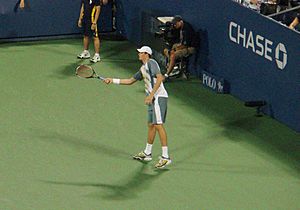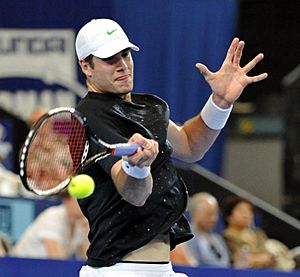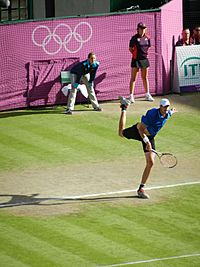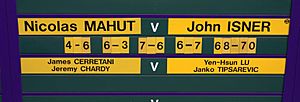John Isner facts for kids
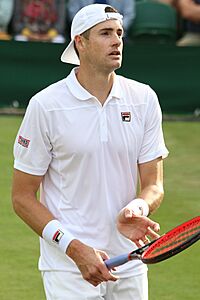
Isner at the 2019 Wimbledon Championships.
|
|
| Full name | John Robert Isner |
|---|---|
| Country (sports) | |
| Residence | Dallas, Texas, U.S. |
| Born | April 26, 1985 Greensboro, North Carolina, U.S. |
| Height | 6 ft 10 in (2.08 m) |
| Turned pro | 2007 |
| Retired | 2023 |
| Plays | Right-handed (two-handed backhand) |
| College | University of Georgia |
| Prize money | US $22,270,428
|
| Official website | www.johnisner.com |
| Singles | |
| Career record | 489–317 (60.67%) (60.7%) |
| Career titles | 16 |
| Highest ranking | No. 8 (July 16, 2018) |
| Grand Slam singles results | |
| Australian Open | 4R (2010, 2016) |
| French Open | 4R (2014, 2016, 2018) |
| Wimbledon | SF (2018) |
| US Open | QF (2011, 2018) |
| Other tournaments | |
| Tour Finals | RR (2018) |
| Olympic Games | QF (2012) |
| Doubles | |
| Career record | 150–114 (56.82%) (56.8%) |
| Career titles | 8 |
| Highest ranking | No. 14 (July 18, 2022) |
| Grand Slam doubles results | |
| Australian Open | QF (2009) |
| French Open | 3R (2008) |
| Wimbledon | 1R (2023) |
| US Open | 2R (2009) |
| Team competitions | |
| Davis Cup | SF (2012, 2018) |
| Hopman Cup | W (2011) |
John Robert Isner (born April 26, 1985) is an American former professional tennis player. He was known for his incredibly powerful serve, which was one of the fastest in tennis history. Standing at 6 feet 10 inches tall, Isner used his height to hit serves that were very hard for opponents to return. He reached a career-high ranking of world No. 8 in singles in July 2018.
Isner is famous for playing the longest professional tennis match ever at the 2010 Wimbledon Championships. This amazing match lasted over 11 hours! He also holds the record for the most aces (serves that opponents can't touch) in the history of the ATP Tour. Isner retired from professional tennis after the 2023 US Open.
Contents
- Early Life and Tennis Beginnings
- College Tennis Career
- Professional Tennis Journey
- Starting His Pro Career (2007-2008)
- Breaking into the Top 40 (2009)
- First Title and the Longest Match (2010)
- Major Quarterfinal and More Titles (2011)
- Reaching the Top 10 (2012)
- More Titles and Masters Finals (2013-2017)
- Career High and Grand Slam Semifinal (2018)
- Later Career and Retirement (2019-2023)
- Longest Matches in Grand Slam History
- Playing Style
- Coaches and Equipment
- Personal Life
- Career Highlights
- Tennis Records
- See also
Early Life and Tennis Beginnings
John Isner was born in Greensboro, North Carolina. He started playing tennis when he was 9 years old. By age 11, he began to take the sport more seriously.
He played for his high school team, Walter Hines Page Senior High School. He helped them win a state championship in 2001. Isner also competed in junior tournaments, including the 2002 US Open.
College Tennis Career
After high school, Isner joined the University of Georgia Bulldogs tennis team in 2003. He was a very strong player in college. He won 143 matches and lost only 28 in singles. In doubles, he won 140 matches and lost 27.
He was often ranked as the top college tennis player in the country. In 2005, he won the NCAA doubles title with his partner, Antonio Ruiz-Rosales. In 2007, his team won the NCAA team event. Isner turned professional after finishing his college career in 2007.
Professional Tennis Journey
Starting His Pro Career (2007-2008)
John Isner started his professional career in the summer of 2007. His world ranking was very low at No. 839. He needed special invitations, called "wildcards," to play in tournaments.
He quickly won his first professional tournament, the USA F14 Futures. Just one month later, he won the Lexington Challenger. This helped his ranking jump to No. 416.
At the Legg Mason Tennis Classic in Washington, D.C., Isner got a last-minute wildcard. He surprised everyone by beating several top players. He reached the final, where he played against fellow American Andy Roddick. This amazing week boosted his ranking to No. 193.
Isner's success earned him wildcards into bigger tournaments, including the US Open. In his first US Open, he defeated a seeded player and reached the third round. He lost to the top player, Roger Federer, but managed to win one set against him. Isner finished 2007 ranked No. 107.
In 2008, Isner played in his first Australian Open. He also played in the French Open and Wimbledon for the first time. He broke into the top 100 rankings in February 2008. He ended the year ranked No. 144.
Breaking into the Top 40 (2009)
In 2009, Isner started working with a new coach, Craig Boynton. At the 2009 Indian Wells Masters, Isner achieved a big win. He defeated Gaël Monfils, who was ranked in the top 10. This was his first victory against a top-10 player.
He also beat former world No. 1 Marat Safin at the same tournament. Later that year, he reached the semifinals of a big tournament in Washington. He defeated top players like Jo-Wilfried Tsonga and Tomáš Berdych.
At the 2009 US Open, Isner had another breakthrough. He defeated Andy Roddick, who was ranked No. 5, in a five-set match. This was his first time reaching the fourth round of a Grand Slam tournament. He finished 2009 ranked No. 34. His fellow players voted him the "ATP Most Improved Player" for that year.
First Title and the Longest Match (2010)
Isner started 2010 by winning his first ATP tour title at the Heineken Open in Auckland. This win moved him into the top 30 rankings for the first time.
He then reached the round of 16 at the Australian Open. He also made it to the finals of the Memphis tournament.
At the 2010 Wimbledon Championships, Isner played in the most famous match of his career. He faced Nicolas Mahut in the first round. This match became the longest match in tennis history. It lasted 11 hours and 5 minutes and was played over three days! Isner won the match with a final set score of 70-68.
After this incredibly long match, Isner was very tired. He lost in the next round. Despite this, he served 113 aces in the match, which was a new record. His performance at Wimbledon helped his ranking reach a career-high of No. 18.
Major Quarterfinal and More Titles (2011)
Isner started 2011 by winning the Hopman Cup mixed doubles event for the United States. He then won his second career title at the Hall of Fame Tennis Championships.
Later that year, he won the Winston-Salem Open. At the 2011 US Open, Isner reached his first Grand Slam quarterfinal. He finished 2011 ranked No. 18.
Reaching the Top 10 (2012)
In 2012, Isner had a great start. He beat world No. 3 Roger Federer in the Davis Cup. He then reached his first Masters 1000 final at the Indian Wells Masters. He defeated world No. 1 Novak Djokovic in the semifinals. After this, Isner entered the top 10 rankings for the first time in his career.
He won the Hall of Fame Tennis Championships for the second year in a row. He also won the 2012 Winston-Salem Open again. At the 2012 London Olympics, Isner reached the quarterfinals.
More Titles and Masters Finals (2013-2017)
In 2013, Isner won his first title on clay courts at the U.S. Men's Clay Court Championships. He also won the Atlanta Open for the first time. He reached another Masters 1000 final in Cincinnati, where he lost to Rafael Nadal.
In 2014, Isner won the 2014 Heineken Open and the Atlanta Open again. He continued to be a strong player, often reaching the later rounds of tournaments.
In 2015, he won the Atlanta Open for the third year in a row. He also reached the semifinals of the Miami Masters. Isner finished 2015 ranked No. 11, his best year-end ranking at that time.
In 2016, Isner reached his third Masters final in Paris. He finished the year as the top-ranked American male player for the fifth year in a row. In 2017, he won two more titles: the Dell Technologies Hall of Fame Open and the Atlanta Open for the fourth time.
Career High and Grand Slam Semifinal (2018)
In 2018, John Isner had one of his best years. He won his first Masters 1000 title at the Miami Open. He defeated Alexander Zverev in the final. This win helped him reach a career-high ranking of world No. 8.
At Wimbledon, Isner reached his first Grand Slam semifinal. He played against Kevin Anderson in a very long match. It lasted 6 hours and 36 minutes, making it the second-longest match in Grand Slam history. Isner lost this close match. He also won the Atlanta Open for the fifth time.
Later Career and Retirement (2019-2023)
In 2019, Isner reached his fifth Masters final at the Miami Open. He continued to be a top player, finishing the year ranked No. 19.
In 2021, Isner won his sixth title at the Atlanta Open, setting a record for the most wins at that event. He also reached the semifinals of the Canadian Open.
In 2022, Isner achieved a rare "Sunshine Double" in doubles. He won the doubles titles at both the Indian Wells Masters and the 2022 Miami Masters. He partnered with Jack Sock for Indian Wells and Hubert Hurkacz for Miami. This made him only the second man in history to win both these big doubles titles in the same year.
At the 2022 Wimbledon Championships, Isner broke the ATP record for the most career aces, passing Ivo Karlovic. He served his 13,729th ace during his match against Jannik Sinner.
In 2023, at the 2023 Dallas Open, Isner won his 500th tiebreak, becoming the first man in the Open Era to reach this milestone. He announced that the US Open would be his final tournament. He played his last singles match on August 31, 2023, and retired from professional tennis on September 1, 2023, after his final doubles match.
Longest Matches in Grand Slam History
John Isner is known for playing in some of the longest tennis matches ever. He has been part of the two longest matches in Grand Slam tournament history.
The Longest Match: Isner vs. Mahut (2010 Wimbledon)
At the 2010 Wimbledon Championships, Isner played Nicolas Mahut in the first round. This match lasted an incredible 11 hours and 5 minutes. It was played over three days!
The final set alone was longer than any previous tennis match. Isner served a record 113 aces in this match. Mahut also served 103 aces. Isner won the match with a final score of 6–4, 3–6, 6–7, 7–6, 70–68.
This match made Isner famous around the world. He and Mahut even won an ESPY Award for "Best Record-Breaking Performance."
| 2010 Wimbledon Championships – Men's Opening Round | 1 (32') | 2 (29') | 3 (49') | 4 (64') | 5 (491') |
|---|---|---|---|---|---|
| 6 | 3 | 67 | 7 | 70 | |
| 4 | 6 | 7 | 63 | 68 |
The Second-Longest Match: Isner vs. Anderson (2018 Wimbledon)
In 2018, Isner played another very long match in the Wimbledon semifinals. He faced Kevin Anderson of South Africa. This match lasted 6 hours and 36 minutes. It was the longest tennis match ever played on Centre Court at Wimbledon.
The match was very close, with many tiebreakers. Anderson eventually won the fifth set with a score of 26-24.
| 2018 Wimbledon's Championships – Men's Semifinals | 1 (63') | 2 (54') | 3 (61') | 4 (43') | 5 (175') |
|---|---|---|---|---|---|
| 7 | 65 | 69 | 6 | 26 | |
| 66 | 7 | 7 | 4 | 24 |
Playing Style
Isner was known for his extremely powerful and consistent serve. His height, 6 feet 10 inches, helped him hit serves very fast and with a lot of spin. He also had a strong forehand shot.
Because of his great serve, Isner won most of his service games. However, his movement around the court was sometimes limited. This often led to long matches where both players held their serves, leading to tiebreaks. His long matches at Grand Slams even led to a rule change in 2022. Now, all four major tournaments use a 10-point tiebreak in the final set to prevent matches from going on for too long.
Coaches and Equipment
Isner worked with several coaches throughout his career. His first coach, Craig Boynton, helped him develop his unique playing style. Later, he worked with Mike Sell, Justin Gimelstob, Rene Moller, and David Macpherson.
Isner was sponsored by Lacoste and Prince for his clothing and rackets for many years. In 2016, he switched his clothing sponsor to FILA.
Personal Life
John Isner studied speech communication at the University of Georgia. He lived in Dallas, Texas.
He married Madison McKinley, a jewelry designer, in December 2017. They have four children together.
Career Highlights
Grand Slam Performance
Isner played in many Grand Slam tournaments throughout his career. He reached the quarterfinals of the US Open twice and the semifinals of Wimbledon once.
| Tournament | 2007 | 2008 | 2009 | 2010 | 2011 | 2012 | 2013 | 2014 | 2015 | 2016 | 2017 | 2018 | 2019 | 2020 | 2021 | 2022 | 2023 | SR | W–L | Win% |
|---|---|---|---|---|---|---|---|---|---|---|---|---|---|---|---|---|---|---|---|---|
| Australian Open | A | 1R | 1R | 4R | 3R | 3R | A | 1R | 3R | 4R | 2R | 1R | 1R | 3R | A | 1R | 1R | 0 / 14 | 15–14 | 52% |
| French Open | A | 1R | A | 3R | 1R | 2R | 3R | 4R | 2R | 4R | 3R | 4R | A | 2R | 3R | 3R | 1R | 0 / 14 | 22–14 | 61% |
| Wimbledon | A | 1R | A | 2R | 2R | 1R | 2R | 3R | 3R | 3R | 2R | SF | 2R | NH | 1R | 3R | 1R | 0 / 14 | 18–14 | 56% |
| US Open | 3R | 1R | 4R | 3R | QF | 3R | 3R | 3R | 4R | 3R | 3R | QF | 3R | 1R | 1R | 2R | 2R | 0 / 17 | 32–16 | 67% |
| Win–loss | 2–1 | 0–4 | 3–2 | 8–4 | 7–4 | 5–4 | 5–3 | 7–4 | 8–4 | 10–4 | 6–4 | 12–4 | 3–3 | 3–3 | 2–3 | 5–3 | 1–4 | 0 / 59 | 87–58 | 60% |
Masters 1000 Finals (Singles)
John Isner reached five Masters 1000 finals in his career, winning one title. These are very important tournaments, just below the Grand Slams.
| Result | Year | Tournament | Surface | Opponent | Score |
|---|---|---|---|---|---|
| Loss | 2012 | Indian Wells Masters | Hard | 6–7(7–9), 3–6 | |
| Loss | 2013 | Cincinnati Masters | Hard | 6–7(8–10), 6–7(3–7) | |
| Loss | 2016 | Paris Masters | Hard (i) | 3–6, 7–6(7–4), 4–6 | |
| Win | 2018 | Miami Open | Hard | 6–7(4–7), 6–4, 6–4 | |
| Loss | 2019 | Miami Open | Hard | 1–6, 4–6 |
Masters 1000 Finals (Doubles)
Isner also had great success in doubles, winning five Masters 1000 titles.
| Result | Year | Tournament | Surface | Partner | Opponents | Score |
|---|---|---|---|---|---|---|
| Loss | 2010 | Italian Open | Clay | 3–6, 2–6 | ||
| Win | 2011 | Italian Open | Clay | w/o | ||
| Loss | 2012 | Indian Wells Masters | Hard | 2–6, 6–7(3–7) | ||
| Win | 2016 | Shanghai Masters | Hard | 6–4, 6–4 | ||
| Win | 2018 | Indian Wells Masters | Hard | 7–6(7–4), 7–6(7–2) | ||
| Win | 2022 | Indian Wells Masters | Hard | 7–6(7–4), 6–3 | ||
| Win | 2022 | Miami Open | Hard | 7–6(7–5), 6–4 | ||
| Loss | 2022 | Italian Open | Clay | 2–6, 7–6(8–6), [10–12] |
Tennis Records
John Isner holds several impressive records in tennis:
- He served 113 aces in a single match at Wimbledon in 2010. This is the most aces ever in an ATP singles match.
- He has served the most aces in the history of the ATP Tour, with 14,470 aces.
- He won 506 tiebreaks in his career, which is the most by any male player in the Open Era.
- He played in the longest singles match ever (11 hours, 5 minutes) at Wimbledon in 2010.
- He played in the longest Grand Slam semifinal ever (6 hours, 32 minutes) at Wimbledon in 2018.
- He won the Atlanta Open 6 times, which is a record for that tournament.
See also
 In Spanish: John Isner para niños
In Spanish: John Isner para niños


